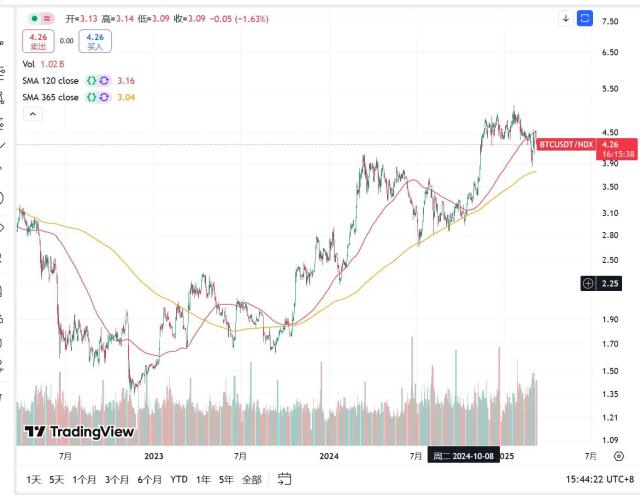Over the past century, humans have redefined the form of computers multiple times.
From the massive computers born in the mid-20th century for rocket navigation, to IBM pushing mainframes into enterprises, to Microsoft and Apple bringing personal computers into every household, and then smartphones putting computers into everyone's pocket.
Each leap in computing power reshaped the way humans connect with the world.
In 2013, 19-year-old Vitalik Buterin, while playing World of Warcraft, first seriously pondered a question after Blizzard arbitrarily weakened the warlock's skills: Who ensures that rules cannot be arbitrarily rewritten in the digital world?
Could a "world computer" that belongs to no company, is not controlled by a single authority, and can be used by anyone become the starting point for the next computing paradigm?
On July 30, 2015, in a small office in Berlin, dozens of young developers stared at the block counter. When the number jumped to 1028201, the Ethereum mainnet automatically launched.
Vitalik recalled: "We all sat there waiting, and then it finally reached this number, and blocks started generating about half a minute later."
At that moment, the spark of the world computer was ignited.
Origin and Spark
Ethereum had fewer than a hundred developers at the time. It was the first to embed smart contracts into the blockchain, providing a Turing-complete stage that made blockchain no longer just an accounting tool, but a world-class public computer capable of running programs.
Soon, this newborn world computer faced a severe test.
In June 2016, a major security incident occurred in the Ethereum-based decentralized autonomous organization "The DAO", where hackers exploited a smart contract vulnerability to steal approximately 50-60 million dollars worth of Ether. The community engaged in heated discussions about whether to "roll back history", ultimately choosing a hard fork to rescue the assets, which also split off another chain - Ethereum Classic.
This event brought the governance issue of the world computer to the forefront for the first time: should immutability be maintained, or should errors be corrected to protect users?
The ICO wave from 2017 to 2018 pushed Ethereum to its peak, with countless projects issuing tokens and raising billions of dollars, driving ETH prices to soar. However, the subsequent bubble burst plunged Ethereum into a trough, with ETH prices dropping over 90% from its high point by the end of 2018, and network congestion and high transaction fees were heavily criticized. During that period, the popularity of CryptoKitties even brought the mainnet to almost a standstill, exposing the first limitations of computing power for this world computer.
To address performance bottlenecks, the Ethereum community had been researching on-chain sharding solutions since 2015, attempting to improve throughput by splitting node verification load. However, sharding technology was complex to implement and progressed slowly. Meanwhile, developers also explored off-chain scaling paths, from early state channels and Plasma to the Rollup solution that emerged in 2019. Rollup significantly improved processing capacity by packaging and submitting large numbers of transactions to the mainnet for validation, but required sufficient data availability support from the mainnet. Fortunately, around 2019, Ethereum made a breakthrough in data availability, solving the problem of large-scale data verification.
Subsequently, Ethereum gradually formed an extension route of "mainnet security, layer-2 execution", and the world computer began to be dismantled into a multi-layer collaborative system.
In the following years, DeFi exploded on Ethereum, with decentralized lending, trading, and derivatives emerging like mushrooms after rain; the NFT boom pushed digital art into the mainstream, with Beeple's work selling for $69 million at Christie's. Although network prosperity was accompanied by persistently high fees, Ethereum began to respond by improving protocols. In August 2021, the EIP-1559 upgrade implemented a base fee burning mechanism, destroying the base fee of each transaction in ETH, thereby reducing inflationary pressure during high-demand periods. This reform led to brief net deflation of ETH during the 2021-2022 bull market, driving its price to near the all-time high of $4,900.
On September 15, 2022, The Merge was completed, and the world computer's core energy switched from the power-intensive PoW to PoS, reducing energy consumption by 99%, decreasing new issuance rate by 90%, and allowing ETH holders to participate in network validation through staking, completely replacing the energy system of this world computer.

Data from a year after the merge shows that Ethereum's net supply has decreased by approximately 300,000 ETH, forming a stark contrast to the originally expected issuance under the PoW mechanism, which strengthened market expectations of ETH's scarcity.
After experiencing these transformations, by the end of 2023, Ethereum's mainnet performance and economic mechanism had improved, but new challenges emerged. To reduce fees and encourage Rollup development, Ethereum implemented the "Dencun" upgrade (Deneb + Cancun) in March 2024, introducing EIP-4844, or Proto-Danksharding technology. This improvement added special "data blob" transactions for Rollup to submit batch transaction data. Since blob data is stored only briefly, its cost is far lower than ordinary call data, thereby significantly reducing the fees for layer-2 networks submitting data to the mainnet. The successful launch of Dencun marked another step towards the sharding goal for the world computer.
Ten years have passed, and this world computer has transformed from an ideal in the white paper to an irreplaceable infrastructure in reality.
However, new dilemmas are quietly emerging behind the bright nodes...
Midlife Fog
As Ethereum enters 2024-2025, its challenges become increasingly apparent.
Layer 2 Diversion Effect Becomes Significant
Ethereum's embraced Rollup-centric route, while alleviating mainnet pressure, has also caused a large number of transactions and value to remain on layer-2 networks, failing to flow back to the mainnet. A Standard Chartered Bank report from early 2025 directly states that the rise of layer-2 networks has eroded Ethereum mainnet's value capture. The report estimates that just Base, a leading Ethereum layer-2 launched by Coinbase, has "taken away" approximately $50 billion in Ethereum ecosystem market value.

Transactions and applications that would have originally been conducted on the mainnet have shifted to lower-cost L2s, resulting in decreased mainnet transaction fee income and on-chain activity. This trend became more apparent after the Dencun upgrade, with EIP-4844 significantly reducing the cost for Rollups to submit data to the mainnet, further increasing L2's attractiveness in handling transactions. In recent years, the daily transaction volume of Rollups like Arbitrum and Optimism has often matched or even exceeded the mainnet, validating the scenario of "Ethereum outsourcing transaction execution".
In other words, the world computer's components are operating efficiently externally, but the main machine's value capture ability is being eroded.
External Public Chain Competition Intensifies
Due to Ethereum's early performance and fee bottlenecks, many competitors have attempted to provide faster and cheaper alternatives.
For instance, Solana, which focuses on high throughput, has attracted numerous developers, with most emerging projects and MEME projects primarily deploying on Solana. In the stablecoin domain, TRON, with its near-zero transaction fees, has carried massive issuance and transfers of mainstream stablecoins like USDT. TRON now has over 80 billion USDT in circulation, surpassing Ethereum in scale to become the largest stablecoin network, with transaction volume also far exceeding Ethereum's. This means Ethereum has surrendered its leading position in this critical track.
Not only that, BNB Smart Chain and other public chains have also captured part of the GameFi and Altcoin trading traffic. Although Ethereum remains the largest ecosystem in terms of DeFi protocol count and TVL, accounting for approximately 56% of DeFi activity in the industry as of July 2025, it is undeniable that Ethereum's relative dominance has declined compared to its peak in a multi-chain landscape.

Governance and Security Concerns
After transitioning to PoS, the issue of staking centralization has raised community concerns. According to the rules, participating in Ethereum network validation requires a threshold of 32 ETH, which encourages retail investors to participate through staking pools or delegated exchanges, ultimately forming a landscape dominated by a few large staking service providers. The largest decentralized staking pool, Lido, once occupied over 32% of the network's staking market share. As more competitors join, Lido's share has slightly dropped to around 25%, but still far ahead of Binance (around 8.3%) and Coinbase (around 6.9%) ranked behind. The community is generally worried that if any single entity holds more than 1/3 of the validation weight, it could potentially affect block consensus and network security.

With the maturity of zero-knowledge proof technologies such as ZK-SNARK and ZK-STARK, performance bottlenecks are expected to be breakthrough, and users who previously overflowed to other public chains and L2 may flow back.
Governance and Economy: How Can Mainchains Regain Value
Not only performance, Ethereum is also thinking about how to continue capturing value for the world computer's core.
In July 2025, the Ethereum Foundation launched a new architectural reform called the "Future of Ecosystem Development", attempting to move from behind the scenes to the forefront and become a helmsman guiding ecosystem development. The foundation proposed two long-term goals: first, to maximize the number of people who directly or indirectly use Ethereum and benefit from its underlying values, and second, to enhance the resilience of technological and social infrastructure.
To this end, the foundation was reorganized around four pillars of "accelerate, amplify, support, and long-term dredging", restructuring internal teams, establishing modules such as enterprise relations, developer growth, application support, and founder support, and strengthening the team's content and narrative to enhance community cohesion.
The foundation also promised to increase transparency, emphasize more targeted public goods funding, launch Launchpad to support governance and sustainable operations, while lowering the proportion of operating expenses and establishing a funding buffer of about 2.5 years.
The outside world generally views this series of actions as a substantive adjustment by the foundation to address criticisms of non-interventionism, and also as a boost for its next decade.
In community discussions, new ideas have emerged: Can a portion of profits be extracted from Layer 2's prosperity? Or optimize protocol fees and MEV distribution mechanisms to allow the mainchain to share growth dividends in the Rollup era. These proposals are still being explored, but they reflect a common concern - if not actively adjusted, the mainchain may degenerate into a mere settlement layer, with value and vitality continuously diluted.
Standing at the Crossroads, Seeking New Sparks
Technology and funds are not enough.
Every peak of Ethereum in the past was ignited by new applications and new narratives. Now, the entire blockchain industry is in an innovation dormancy period, lacking phenomenal breakthroughs.
Perhaps blockchain itself needs a self-revolution, generating new narratives and applications in social, identity, AI, and other fields. Some believe the next breakthrough may come from external ecosystem impacts.
Vitalik once reminded in his "Next Decade of Ethereum" speech that Ethereum developers should not just copy Web2, but should face future interaction forms, including wearable devices, AR, brain-computer interfaces, and local AI, incorporating these new entry points into Web3 design vision.
Looking back over the past decade, Ethereum still has the industry's largest developer community, the richest applications, and deep technical accumulation. But it is facing a moment of intersection between bottlenecks, competition, and emerging challenges.
As Vitalik said: "The past decade of Ethereum was our decade focused on theory. In the next decade, we must change our focus and think about what impact we will have on the world." In his view, the next generation of applications must not only have different functions but also retain shared values, and these applications must be good enough to attract those who have not yet entered the crypto field.
The world computer, at its ten-year itch. It has not stopped running, just searching for a new direction.
The next decade belongs to it, and to everyone who still believes in this dream.
But as Vitalik says, "Everyone who speaks in the Ethereum community has the opportunity to participate in the process of building the future together."
Click to learn about BlockBeats job openings
Welcome to join the BlockBeats official community:
Telegram Subscription Group: https://t.me/theblockbeats
Telegram Discussion Group: https://t.me/BlockBeats_App
Twitter Official Account: https://twitter.com/BlockBeatsAsia






